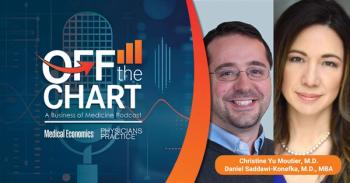
Five necessary steps to address professional burnout in healthcare
Burnout can be mitigated with a process that mirrors the methodology used to diagnose and care for patients.
The length and intensity of the pandemic in the United States has been an exhausting and traumatic experience for the healthcare professionals on the front lines of caring for COVID-19 patients. The mental health of these doctors, nurses, respiratory therapists, custodians, and other hospital professionals is a critical concern for our industry, but this issue is not limited to hospitals. Burnout is a nationwide crisis among physicians and other healthcare professionals at small and medium-sized healthcare providers including physician-owned practices.
The pandemic did not create this growing crisis, but it did amplify it to an unprecedented degree. Before the pandemic, research conducted by MGMA reported that 47% of respondents were feeling a high level of burnout. Add in those reporting moderate levels of burnout, and the percentage of respondents in or near the "red zone" jumps to 84%—and that was before the pandemic intensified the pressures on healthcare professionals across the healthcare system.
The Rising Levels of Burnout
The pre-pandemic factors driving such high levels of burnout include the pressure to achieve ever-higher patient volumes, relentlessly long work hours, obstacles that prevent spending more time with each patient, daily battles with insurance companies and Medicare, the downward pressure on small practices coming from competing healthcare providers, and—for physician-owned practices—the stress of being a business owner on top of everything else.
The pandemic added to all of that overnight with a wave of additional stressors. When medical practices were not deemed essential businesses at the beginning of the pandemic, physician practices had to close their doors with no clear understanding of when and how they would be able to see patients again. Revenue was turned off like a faucet. Many practices laid off their staffs. And the PPP loan process was difficult or fruitless to navigate for many practice owners.
Those stressors shifted but did not abate when medical practices were allowed to reopen. Patient volumes for primary care have not returned to pre-pandemic levels; costs have gone up due to COVID-19 precautions; and nearly every aspect of delivering care is more difficult, more expensive, less profitable, and more frustrating. In addition, physicians are now often working with short-handed staffs reflected in the
I have not yet seen a quantitative study examining the impact the pandemic has had on healthcare industry burnout, but it doesn’t take a statistician to see that the industry’s exhaustion is at an all-time high. A physician-owned medical group in Texas just sold their practice to a large provider—essentially throwing up their hands in response to the untenable situation faced by their physicians and staff. Every week, my team and I hear of more nurses who are making career changes. And I can hear the level of weariness in physicians’ voices. The anecdotal evidence is clear, and I believe the numbers will bear that out as more research is completed.
5-Step Process for Addressing Burnout Causes
The industry is facing a brain drain of talented physicians and healthcare professionals leaving the field, which will have significant negative impacts on patients and collectively weaken a crucial part of the U.S. healthcare system if left unchecked. To make progress on this issue, however, we need to take a different approach than the typical half measures that have been so commonly used.
Prior efforts to address this burnout epidemic have typically focused on treating the symptoms rather than the underlying issues. Those prior efforts typically focused on encouraging more work-life balance, promoting self-care and time off, offering access to fitness services and mental health support, and so forth. All of that has an important role to play in how we tackle this issue, but it is not enough. It is a Band-Aid on a cut that requires 30 stitches. Unless you address the underlying issue—that gaping wound, for example—then the Band-Aid can’t possibly help.
I believe there are three areas of chronic frustration for healthcare providers that contribute greatly to burnout:
- Technology
- Payment processing
- Patient care access
Regular readers of Physicians Practice can list half a dozen issues that cause them daily headaches in each of these areas. Those frustrations are chronic, leaving people feeling discouraged and disempowered daily, but they are fixable if medical practices take the following systematic, five-step approach to eliminating some of these challenges that contribute significantly to weariness and exhaustion. It is a process that mirrors the methodology used to diagnose and care for patients:
- Collecting subjective and objective information about the patient
- Assessing the collected data to identify problems and set priorities
- Creating an individualized care plan that is evidence-based and cost-effective
- Implementing the care plan
- Monitoring the patient over time during follow-up encounters to evaluate the effectiveness of the plan and modify it as needed.
Every medical practice should begin eliminating sources of burnout causation in the areas of technology, payment processing, and patient care access with this five-step approach. In each of the three causation areas, the cross-functional work group should identify the data about the practice or providers that is most problematic and then prioritize which issues they’re going to target to resolve (Steps 1 and 2). The working group should then develop and implement solutions (Steps 3 and 4), and then monitor those measures to determine if they are positively impacting the metrics they set out to fix (Step 5).
Tackling one of the three causation areas at a time will make this process more manageable. And each of the causation areas should have a custom working group that matches the specific area in question.
Taking Action on Burnout
For the chronic frustrations around technology, start with a closer look at EHRs, which often are the source of inefficiency throughout a practice. For example, physicians often ask for “a new EHR” when what they really need is for the EHR template to be customized to match common types of cases. These requests for new EHRs slow down the physician’s workflow and create additional work for other team members. The working group using the five-step process may solve this issue with customized EHRs that provide the physician with what they need while also streamlining processes and reducing workloads. The working group may identify other frustrations related to EHRs, scheduling software, patient access portals, and other technology, which if addressed collectively could remove a significant amount of chronic frustration for physicians and staff.
Frustrations regarding payments also can be mitigated with the five-step methodology. Every practice has challenges with payment processing: Common issues include insurance verification/prior authorization, patient collections, denials/claim adjudication with private payers, billing issues, and timeliness of payment resulting in cash flow challenges. A working group focused on simplifying the payment process can use the five-step methodology to determine the biggest pain points for physicians, staff, and patients and prioritize improvements that collectively remove a significant amount of stress on an organization. Individually, the improvements may seem minor, but in total they will lessen the kind of chronic stress that wears down doctors and their teams day after day.
In the area of patient care, some of the most common sources of chronic frustration at medical practices involve difficulties with patient access, patient education, devoting time to the patients who need it, gauging treatment adherence and prescription management. Each of these are chronic areas of frustration that seem unchangeable, until a working group begins looking closely at incremental changes that would collectively make a major positive impact. The five-step methodology takes seemingly large and inflexible issues and identifies practical steps to successfully achieve improvements that physicians, staffs, and patients will see and feel.
As impactful as it is, burnout isn’t the sole impetus for taking these steps. As our industry moves toward value-based care (VBC), these burnout mitigation strategies to reduce daily frustrations will make medical practices’ operations healthier and more adept in making the transition to VBC models of healthcare. Healthcare leaders have diagnosed the problem of burnout and recognize that change is necessary to continuing evolving and sustaining our care teams and the business of medicine. Looking at the issue with fresh eyes and taking these new steps will lead the industry further in our journey to healthier practices to serve our communities throughout the pandemic and beyond.
About the Author
Andy Swanson, MPA, CMPE, is the Vice President of Industry Insights at Medical Group Management Association (MGMA)
Newsletter
Optimize your practice with the Physicians Practice newsletter, offering management pearls, leadership tips, and business strategies tailored for practice administrators and physicians of any specialty.









